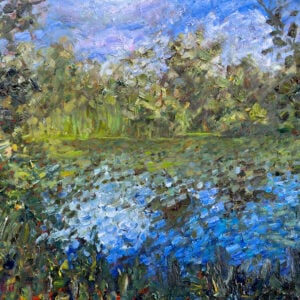Gesso is what is commonly used to prime your canvas. By prime, I mean getting it ready to paint on. The purpose of gesso is to stop paint from sinking into the canvas weave (which would quickly deteriorate the canvas) and provide a responsive surface to paint on.
Most canvases you buy from the art store are already primed and nothing further is needed from you before you paint on it. However some artists prefer to add some additional layers of gesso.
Gesso is similar to a white acrylic paint, but it is generally thinner and dries harder.
The texture of different brands of gesso varies, with some being more smooth and refined and others more rough. You can add additional rough texture and variance by the way you apply the gesso.
Gesso is generally applied in a number of layers to build up a thick base on the canvas. A large brush and / or palette knifes can be used to apply the gesso.
If you are painting a landscape then a more rough gesso background may be preferred to help render the harshness of the environment. For more delicate subjects such as portraits, you may prefer a more smooth and refined gesso background to work on.
- What is Gesso?
- Different Types of Gesso
- How, and When, to Apply Gesso to Canvas?
- Want to Learn More?
- Thanks for Reading!
What is Gesso?
Gesso is a white paint-like mixture that is applied to a painting support as an initial preparatory layer, also known as a ground or primer. It can be applied to canvas or wood supports and consists of a binding material that is mixed with white pigment, chalk or gypsum. Gesso is used for a variety of reasons:
- To protect the support from the paint and prevent paint from sinking into the weave of the canvas
- To help the paint adhere to the surface of the support
- To provide a smoother surface to paint on
Gesso is an Italian word that means ‘chalk’ or ‘plaster’. Gesso has been used by artists since antiquity and became popular with Italian Renaissance panel painting. A wooden support was not always smooth enough to paint on, so artists had to devise a method to create a smoother surface that would also hold the paint. This is where gesso comes in. Artists or their assistants would apply a first, rough layer called gesso grosso to the panel, followed by lots of thin layers called gesso sottile. Each layer was scraped and sanded between applications to make sure the surface was as smooth as possible.
Different Types of Gesso
Today’s gesso is a bit different than the gesso used in the Renaissance. Traditional gesso was a mixture of gypsum, rabbit-skin glue, and white pigment. This type of gesso works well with tempera, oil paint, and gold leaf. It is not suitable for canvas surfaces, as it is too brittle and can crack easily.
Modern versions of gesso, called “acrylic gesso” contain calcium carbonate (chalk), acrylic polymer emulsion, and white pigment (usually titanium dioxide). Acrylic gesso is more flexible than traditional gesso and is best used with acrylic paints, rather than tempera or oil.
Different brands of gesso have different textures. Some are rough and others are smooth. You can choose which texture you’d like based on the subject or style you are painting. For more energetic, textured scenes, a rough gesso is helpful. For more refined subjects, like portraits or hyperrealism, smooth gesso works well.
How, and When, to Apply Gesso to Canvas?
Most modern canvases purchased from art stores are already primed and do not need gesso. However, some artists may choose to add their own layers of gesso based on how they want their paintings to look. If you notice your paint sinking into the weave of the canvas, or appearing mottled after application, it is a good idea to test out some gesso layers. Experimenting with one or multiple layers of rough or smooth gesso will help you determine if it is right for you and your artwork.
To get started, try the following steps:
- Using a wide, flat brush, apply gesso to the canvas with long, even brushstrokes.
- This first coat can be diluted with a bit of water, if desired.
- Cover the entire canvas as evenly as possible.
- Allow the gesso to dry.
- Apply a second layer of gesso.
From here, it’s up to you to decide if you need any additional layers of gesso. Experiment with painting on canvases with two, three, or more layers of gesso and see how you like the result. If you want an ultra-smooth surface, try sanding each layer of gesso after it dries by rubbing the surface evenly with sandpaper. You can also experiment with tinted gesso by adding a bit of acrylic paint to your gesso. This is helpful if you want a colored or dark background.
Want to Learn More?
You might be interested in my Painting Academy course. I’ll walk you through the time-tested fundamentals of painting. It’s perfect for absolute beginner to intermediate painters.
Thanks for Reading!
I appreciate you taking the time to read this post and I hope you found it helpful. Feel free to share it with friends.
Happy painting!
Dan Scott

Draw Paint Academy






